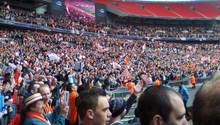Luton Town F.C.
Wanderers secretary Herbert Spratley seized upon Deacon's idea and arranged a secret meeting on 13 January 1885 at the St Matthews school rooms in High Town.[6] Initially based at Excelsior's Dallow Lane ground,[5] Luton Town began making payments to certain individual players in 1890.[7] Captain and left winger Bob Hawkes became Luton's first international player when he was picked to play for England against Ireland on 16 February 1907.[11] A poor 1911–12 season saw Luton relegated to the Southern League's Second Division; the club won promotion back two years later.Simms was invalided back to England after being wounded on the Italian front,[12][14] but recovered enough to regain his place in the Luton team and scored 40 goals during the 1916–17 season.[17][18] However, after Luton finished fourth in the division, the squad was broken up as Simms, Bookman and Mathieson joined South Shields, Port Vale and Exeter City respectively.[21] Towards the end on the 1936-37 season Eddie Parris became the first Black player to represent Luton when he made his debut on 13 March 1937 in a home game against Northampton Town.[24] The team included Gordon Turner, who went on to become Luton's all-time top goalscorer,[25] Bob Morton, who holds the record for the most club appearances,[26] and Syd Owen, an England international.A team including Bruce Rioch, John Moore and Graham French won the Fourth Division championship in 1967–68 under the leadership of former player Allan Brown;[8] two years later Malcolm Macdonald's goals helped them to another promotion,[37] while comedian Eric Morecambe became a director of the club.Talented players such as Ricky Hill, Brian Stein and Emeka Nwajiobi made key contributions to the club's success during this period,[39] causing it to accrue "a richer history of black stars than any in the country", in the words of journalist Gavin Willacy.[41] A late winner by Yugoslavian substitute Raddy Antić saved the team and prompted Pleat to dance across the pitch performing a "jig of joy",[41] an image that has become iconic.With ten minutes left on the clock and Arsenal 2–1 ahead, a penalty save from stand-in goalkeeper Andy Dibble sparked a late Luton rally: Danny Wilson equalised, before Brian Stein scored the winner with the last kick of the match.[56] These deductions proved to be too large an obstacle to overcome,[57] but Luton came from behind in the final of the Football League Trophy to win the competition for the first time.In the 2012–13 FA Cup fourth round, Luton won their away tie against Premier League club Norwich City 1–0 and, in doing so, became the first non-League team to beat a side from England's top division since 1989.[59] In the 2013–14 season, under the management of John Still, Luton won the Conference Premier title with three games to spare, and thereby secured a return to the Football League from 2014–15.[63][64] Luton achieved a second successive promotion in 2018–19, after they won the League One title, marking the club's return to the Championship after a 12-year absence.[69] After collecting one point in their first five matches of the season, Luton won their first Premier League game on 30 September 2023, beating Everton 2–1 away at Goodison Park.The new emblem depicted a stylised orange football, bearing the letters "Lt", surrounded by the club's name in navy blue text.The "rainbow" badge, introduced in 1994, featured the town crest below an orange and blue bow which curved around to meet two footballs, positioned on either side of the shield, with the club name underneath.[77] This badge was used until 2005, when a replacement very similar to the 1987 version was adopted, featuring black text rather than blue and a straw boater in place of the outstretched arm depicted in the older design.[113][114] The club did not rule out redeveloping Kenilworth Road and, in October 2012, entered talks to buy the stadium back from Luton Borough Council.[133] A character known as Happy Harry, a smiling man wearing a straw boater, serves as the team's mascot and appears on the Kenilworth Road pitch before matches.[137] Six players, Gordon Turner, Andy Rennie, Brian Stein, Ernie Simms, Herbert Moody and Steve Howard, have scored more than 100 goals for Luton.[138][139][140][141] The first player to be capped while playing for Luton was left winger Robert Hawkes, who took to the field for England against Ireland at Goodison Park on 16 February 1907.[147] The most expensive player Luton Town have ever bought was wing-back Ryan Giles, for a reported fee of £5 million from Wolverhampton Wanderers on 27 July 2023.[citation needed] The youngest player to make a first-team appearance for Luton Town is Connor Tomlinson at 15 years and 199 days old in the EFL Trophy, replacing Zane Banton as a 92nd-minute substitute in a 2–1 win over Gillingham on 30 August 2016, after the club were given permission for him to play from his headteacher.The club operates a Development Squad, made up of contracted senior players, youth team scholars and trialists, which plays in the Southern Division of The Central League.











LTFC (disambiguation)Kenilworth RoadMatt BloomfieldEFL Championship2023–24Premier LeagueHome coloursAway coloursThird coloursCurrent seasonfootballBedfordshirethe English football pyramidFootball League1897–98 season1955–56Nottingham Forest1959 FA Cup final1959–60Fourth Division1965–66 season1974–751981–82Second DivisionArsenal1988 Football League Cup final1991–92 season2008–09 seasonnon-League footballConference Premier2013–14League TwoLeague One2017–182018–192023 Championship playoffsHistory of Luton Town F.C. (1885–1970)History of Luton Town F.C. (1970–present)High TownDallow LaneSouthern Football LeagueUnited Leaguethe Football League1897–98Dunstable Road1900–01 seasonCaptainBob HawkesEnglandIreland1911–12 seasonFirst World WarThe London Combination1915–16friendly matchesErnie SimmsforwardItalian front1916–17 seasonJoe Payne1920–21 seasonsky blueWindsor ParkLouis BookmanAllan MathiesonSouth ShieldsPort ValeExeter CityThird Division South1936–37strikerBristol RoversEddie ParrisNorthampton TownDally DuncanGordon TurnerBob MortonSyd OwenRon BaynhamBernard StretenIrish internationalsSeamus DunneTom AherneGeorge Cumminstop flightBirmingham Citygoal averageFA Cup Final appearance1958–59FWA Footballer of the Year1964–65fourth tieryo-yo clubBruce RiochJohn MooreGraham French1967–68Allan BrownMalcolm MacdonaldEric Morecambe1973–74the following seasonDavid Pleat1982–83Ricky HillBrian SteinEmeka NwajiobiManchester CityMaine RoadYugoslavianRaddy Antićiconic1986–87Ray HarfordFootball League Cup3–2 winAndy DibbleDanny WilsonLeague Cup Final1988–89four years later2000–01 seasonJoe KinnearJohn GurneyMike Newelladministration